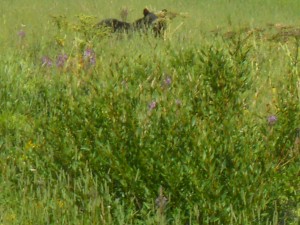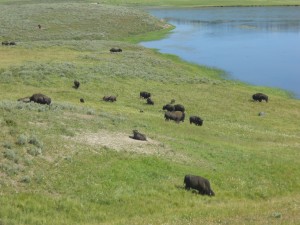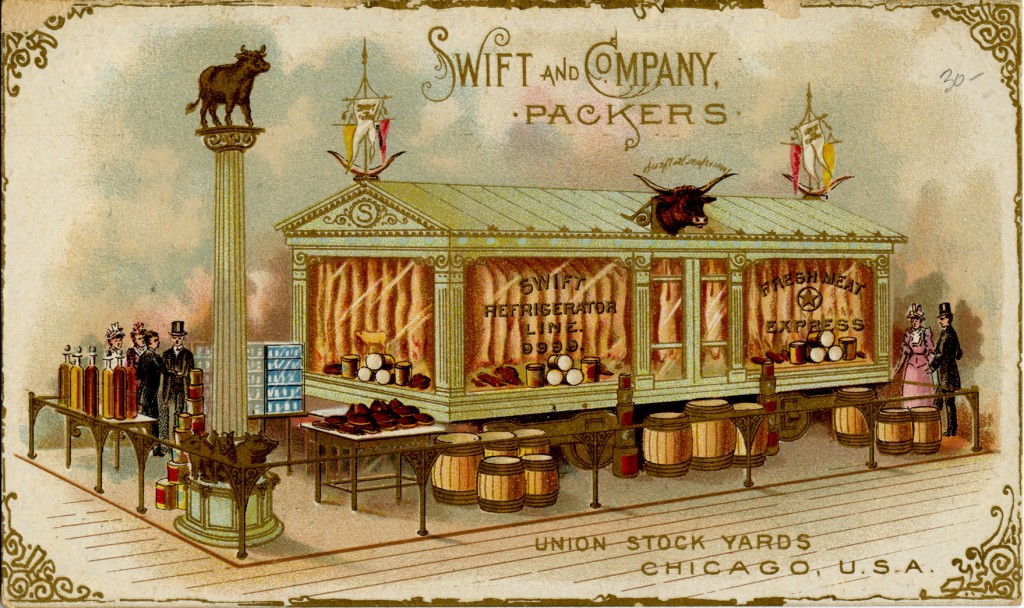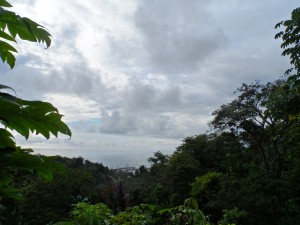In the 1950s United States Secretary of Agriculture Ezra Taft Benson told farmers to “get big or get out.” Today, if one looks at the industrial livestock sector it seems that Benson’s vision of large-scale agriculture has come to fruition. The contemporary meat industry in the United States is a powerful force in both business and politics. The rise of the sector can be explained by a number of developments in production and technology dating back to the first European settlements in North America. Continue reading
Category Archives: Climate Change
Global Warming and Wildlife in National Parks: A History of This Hot Topic

A grizzly bear gazes through vegetation in Yellowstone National Park. Photo courtesy of Madeline Hirshan.
Climate change is a phenomenon that has been a long time in the making. The last ice age ended about 7,000 years ago. This spawned the beginning of the era of human civilization. In the past, changes in climate mostly occurred from variations in Earth’s orbit affecting how much solar energy reached Earth’s surface. More recent trends lean towards rapid changes in climate due to human induced warming. According to BBC News, the likely source of climate change occurred during the 18th century with the onset of the Industrial Revolution. Centuries of human population growth and discovery have led us to this troubling point. Investigations of “greenhouse gases” had begun as early as 1824 and research regarding their properties took place around 1861. The current state of the Earth’s climate can be attributed to numerous causes including the burning of fossil fuels which trap heat in the atmosphere and re-emit it back to the surface.
Although there are many ways in which humans have left a negative carbon footprint on this planet, many important decisions had been made in the past that have preserved the environment in some fashion. National parks were created to protect key areas from extreme human intervention. Yellowstone National Park was formed in 1872 and was placed under the control of the Secretary of the Interior. The Yellowstone Act states: “He [Secretary of the Interior] shall provide against the wanton destruction of the fish and game found within said park, and against the capture or destruction for the purposes of merchandise or profit.” The numbers of national parks have increased and continue to preserve diverse and immaculate landscapes and wildlife in addition to unique cultural and historical sites. The National Parks System of the United States currently has more than 400 locations represented in forty-nine states.
Are animals in protected areas shielded from climate change?

Bison scattered along the landscape of Yellowstone National Park. Photo courtesy of Madeline Hirshan.
Climate change is a very current and pressing issue that is likely to have severe implications such as rising sea levels and increased extreme weather events. Humans are likely to be affected by these changes as will other animals that roam the Earth. Wildlife rely so heavily on the environment that is destined to be altered by impending climate change. They have specific needs for resources, such as food and shelter that only their environment can provide. Wildlife depend on certain temperature cues or ranges for normal life processes such as laying eggs and migrating. Global warming could possibly alter these “cues,” as well as present other challenges like changes in home ranges and mating patterns, and forest depletion due to heat stresses. Scientists are working to uncover how wildlife are responding to these environmental changes in current warming, as well as making projections about effects of increased future warming.
The Truth about Travel: How Eco-Friendly is your Hotel?
Sitting on the cliffs of the Osa Peninsula in Costa Rica, next to the coast of the Pacific Ocean, is a small eco-lodge called Lapa Rios where visitors from around the world can escape from the modern world and find nature again. Nestled on 1000 acres of rainforest, this lodge offers 50 guests an opportunity to not only have fun, but to also lessen their impact on the fragile ecosystem of the rainforest while supporting the local economy. The experience is the epitome of the burgeoning field of ecotourism.
Ecotourism is a growing trend around the world. According to the International Ecotourism Society, the brand of travel has grown 20 percent to 34 percent each year since 1990. Ecotourism is defined by Merriam-Webster Dictionary as “the practice of traveling to beautiful natural places for pleasure in a way that does not damage the environment there.” And yet it has become so much bigger than just the environment. In order to participate in true ecotourism, lodges must take into account how they are affecting the local community. Ecotourism is about being local. Continue reading

